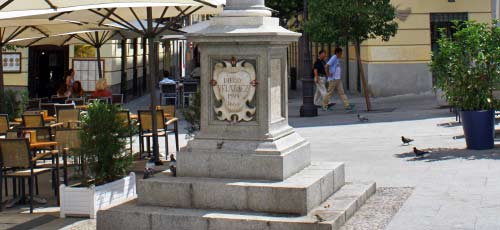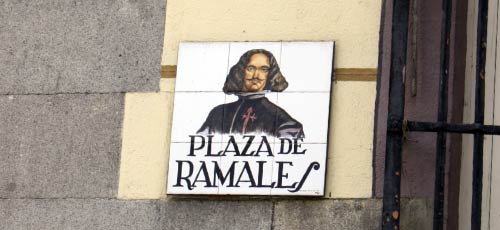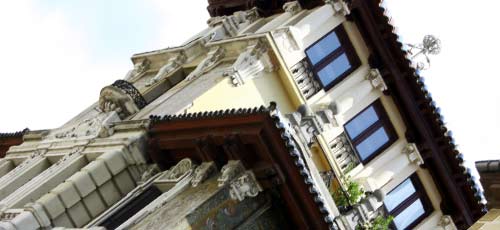Madrid-Tourist.com
The best independent guide to Madrid
Madrid-Tourist.com
The best independent guide to Madrid
Plaza Ramales, Madrid Guide
The Plaza Ramales is a tranquil paradise in the hubbub of Madrid and is far enough off the common tourist trail not to be swamped by tourists. The Plaza Ramales is the final resting place of Madrid’s most celebrated artist, Diego Velázquez and hidden below the square intrigue and mystery prevails.
The Plaza Ramales leads off from the Jardines Lepanto part of the much larger Plaza de Oriente and in the opposite direction connected to the Plaza Isabel II were the nation theatre (Teatro Real) is located. During the summer months the three restaurants/cafes line the centre of the plaza with tables and parasols enticing tourist to sit and seek shelter from the heat of the summer sun.

The area is fully pedestrianized with tranquility of Plaza Ramales only interrupted by the passing of tour buses on the way to the Palacio Real de Madrid. Plaza Ramales was constructed on the site of the royal church of Madrid, the San Juan Bautista (Church of Saint John the Baptist) which had a large monastery attached. Much of early Madrid history revolved around the San Juan Bautista with royal weddings and baptism performed here up until 1639.
The fortune of the San Juan Bautista changed dramatically during the building frenzy of Joseph Bonaparte’s reign of 1808 to 1813. The French conquest had little time for the powerful church of Spain and set about systematically eroded its power base including the destruction of many important churches and monasteries.

The reclaimed land was then transformed into large plazas and gardens and a great number of houses were removed to create the wide boulevards which crisscross Madrid. The San Juan Bautista was one of the churches that was cleared, being pulled down in 1811 but the outline of the church can still be traced within Plaza Ramales by observing the differences in the stones laid into the ground.
The most significant event during the later history of the San Juan Bautista was that Diego Velázquez and his wife Juana were buried in the crypt of the church. Diego Velázquez was Spain’s most accomplished artist and the private artist of King Philip IV, Velázquez died on the 6th August 1660 and his darling wife died only 8 days later, both were buried together.

The area below Plaza Ramales was excavated during the mid 90’s to build a large underground car park to serve the popular tourist area and the Teatro Real. Before the digging an archaeological team surveyed the area hoping to locate the crypt and to remove the remains of one of Spain’s most revered artists. During the painstaking operation only one set of skeleton remains were located and after scientific analysis was identified not to be the remains of Diego Velázquez or his wife.
There were documents from the era that stated Diego Velázquez was buried within the crypt below the San Juan Bautista but neither the archaeologist nor the excavation teams could locate his crypt or remains. Velázquez missing remains are one of the many mysteries of Madrid. Peculiarly, the square is not named after the great artist who lies supposedly below but after a minor battle fought as part of the First Carlist war. Ramales is a small town in Cantabria, in northern Spain and the Battle of Ramales (12th May 1839) was fought between the Carlists (supporting the Infant Carlos) against the Liberals (supporting Isabella II of Spain and her regent mother Maria Christina). The protracted civil war was eventually won by Isabella II and it was her vision which is responsible for many of the ornamental transformations of Madrid which occurred in the late 19th century. Prior to the battle the Plaza Ramales was known as the Plaza San Juan, named after the old church of San Juan Bautista.
The buildings which surround the Plaza Ramales were constructed between 1890-1900. The most decorative of these buildings lies on the east side of the plaza facing out towards the Plaza de Oriente with the top levels painted with colourful drawings and patterns which closely resemble the Plaza de Mayor. This building was constructed in two distinct periods with the first 3 levels in 1894 and the top added later in 1904 as an early style penthouse with all the modern day features of the era, including ornate painted facade.
Madrid Holiday Guide
|
| ||||||
|
| ||||||
|
| ||||||
|
| ||||||
|
|









